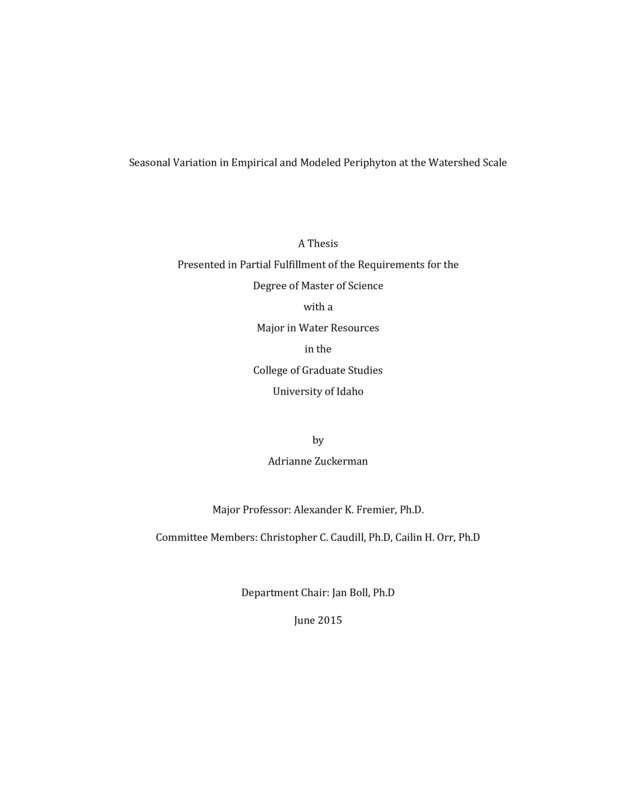Seasonal Variation in Empirical and Modeled Periphyton at the Watershed Scale
Zuckerman, Adrianne. (2015). Seasonal Variation in Empirical and Modeled Periphyton at the Watershed Scale. Theses and Dissertations Collection, University of Idaho Library Digital Collections. https://www.lib.uidaho.edu/digital/etd/items/zuckerman_idaho_0089n_10632.html
- Title:
- Seasonal Variation in Empirical and Modeled Periphyton at the Watershed Scale
- Author:
- Zuckerman, Adrianne
- Date:
- 2015
- Embargo Remove Date:
- 2016-08-14
- Keywords:
- Biomass Mechanistic Modeling Periphyton Restoration Stream Ecology Watershed
- Program:
- Water Resources
- Subject Category:
- Limnology; Biology; Aquatic sciences
- Abstract:
-
The decline of Pacific salmon has fueled concerns about declining ecosystem productivity following the loss of salmon-supplied nutrient and material subsidies that supported primary and secondary production. Due to decreased salmon subsidies, freshwater ecosystems may be experiencing a bottom-up limitation of aquatic production which restricts current and future production. I used two contrasting approaches to understand the spatial and temporal patterns of basal resources in the form of periphyton biomass across a large temperate, mountainous watershed over one year. I examined the relationship between field collected periphyton biomass compared to physical, chemical, and biological environmental parameters to understand what parameters affected biomass. Specifically, I used empirical data collected monthly at 12 sites across a 5th order watershed for one year to investigate: the (1) spatial and temporal patterns of periphyton biomass across a watershed. Evaluate (2) which environmental variables are the best predictors of biomass and if they (3) change seasonally. As a second approach to understand basal resources, I tested the accuracy of a formalized mechanism-based model, the Aquatic Tropic Productivity Model (ATP Model), developed by Bellmore et al. (2014). I simulated periphyton biomass across the same sites as the empirical study and used the environmental parameter data collected in the field to code the model. I (4) compared simulated biomass values to field collected biomass and examined how accurately a mechanism-based model performed in simulating biomass patterns compared to empirical patterns. Results of the empirical investigation indicate that drivers of periphyton shift seasonally. Solar access, nitrogen, and disturbance effects are important drivers throughout the year across the basin, though rank changes by season. In the snowmelt-dominated watershed, the highest observed periphyton was observed in winter (January – March), whereas the ATP Model predicted the highest biomass in autumn, (from October-December). In spite of this difference, the ATP model generated biomass estimates within the SE of observed values by site. As a result, the ATP Model could be used to predict aquatic basal resources in order to prioritize restoration locations and activities that support basal resource production that feed focal aquatic populations (such as Pacific salmon), though a few refinements are still needed.
- Description:
- masters, M.S., Water Resources -- University of Idaho - College of Graduate Studies, 2015
- Major Professor:
- Fremier, Alexander K
- Committee:
- Caudill, Christopher C; Orr, Cailin H
- Defense Date:
- 2015
- Identifier:
- Zuckerman_idaho_0089N_10632
- Type:
- Text
- Format Original:
- Format:
- application/pdf
- Rights:
- In Copyright - Educational Use Permitted. For more information, please contact University of Idaho Library Special Collections and Archives Department at libspec@uidaho.edu.
- Standardized Rights:
- http://rightsstatements.org/vocab/InC-EDU/1.0/

